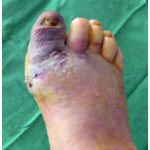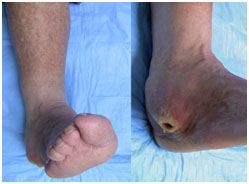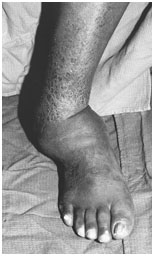Diabetes is a condition of elevated blood sugar that affects about 6 percent of the population in the United States, or about 16 million people. Diabetic foot problems are a major health concern and are a common cause of hospitalization.
Most foot problems that people with diabetes face arise from two serious complications of the disease: nerve damage and poor circulation. One of the more critical foot problems these complications can cause is Charcot arthropathy, which can deform the shape of the foot and lead to disability.
There are treatment options for the wide range of diabetic foot problems. The most effective treatment, however, is prevention. For people with diabetes, careful, daily inspection of the feet is essential to overall health and the prevention of damaging foot problems.
Description

A severely infected big toe. This infection began two days previously as a small blister at the tip of the toe.
Nerve damage (neuropathy) is a complication of diabetes that leads to a loss of sensation in the feet. Some people with diabetes can no longer feel when something has irritated or even punctured the skin. A wound as small as a blister can progress to a serious infection in a matter of days.
Diabetes also damages blood vessels, decreasing the blood flow to the feet. Poor circulation weakens bone, and can cause disintegration of the bones and joints in the foot and ankle. As a result, people with diabetes are at a high risk for breaking bones in the feet.
When a diabetic fractures a bone in the foot, he or she may not realize it because of nerve damage. Continuing to walk on the injured foot results in more severe fractures and joint dislocations. Sharp edges of broken bone within the foot can point downward toward the ground, increasing the risk of chronic foot sores from the abnormal pressure.

(Left) This patient with Charcot of the ankle has developed a deformity that places abnormal pressure on the outside of the ankle. (Right) This pressure has led to the development of a chronic sore (ulcer) that can be extremely difficult to treat.
The combination of bone disintegration and trauma can warp and deform the shape of the foot. This condition is called Charcot arthropathy, and is one of the most serious foot problems that diabetics face.

This patient with Charcot arthropathy has a severe deformity caused by the breakdown of the ankle joint.
Symptoms
Although a patient with Charcot arthropathy typically will not have much pain, they may have other symptoms.
- The most sensitive sign of early Charcot foot is swelling of the foot. This can occur without an obvious injury.
- Redness of the foot can also occur in the early stages.
- The swelling, redness, and changes to the bone that are seen on x-ray may be confused for a bone infection. A bone infection is very unlikely if the skin is intact and there is no ulcer present.
